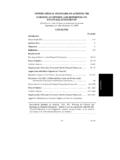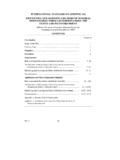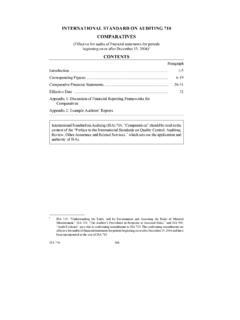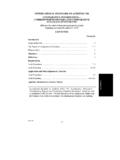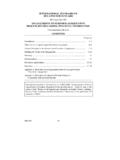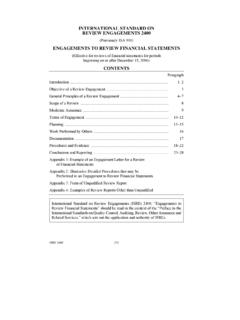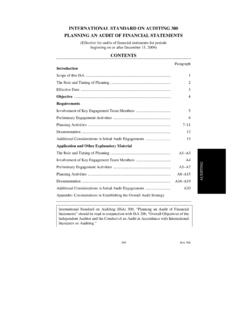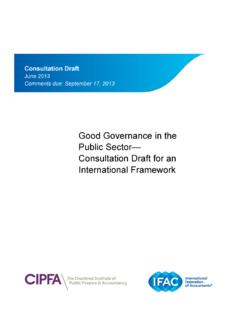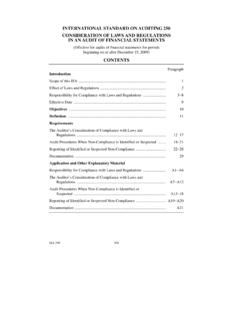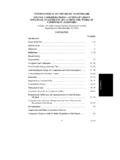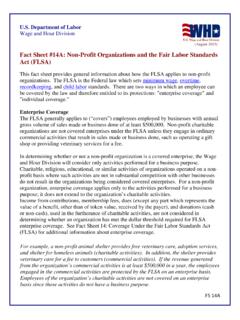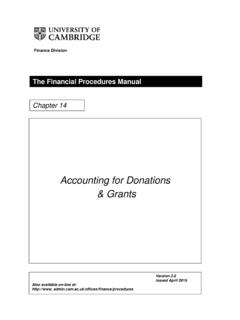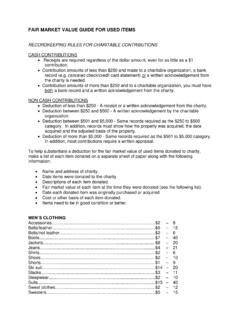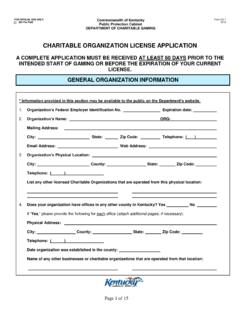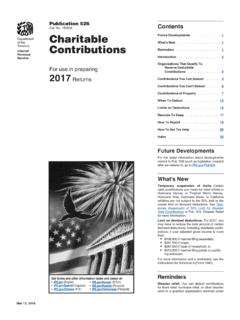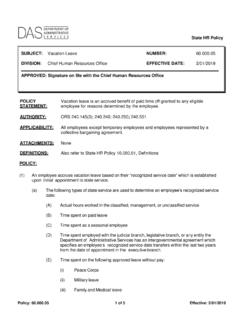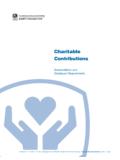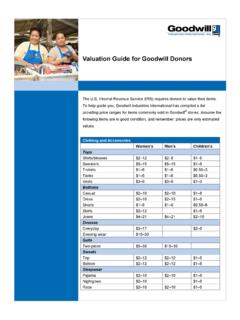Transcription of IPSAS 23 REVENUE FROM NON-EXCHANGE TRANSACTIONS …
1 PUBLIC SECTOR December 2006 IPSAS 23 REVENUE FROM NON-EXCHANGE TRANSACTIONS (TAXES AND TRANSFERS) CONTENTS Paragraph Introduction .. IN1 IN5 Objective .. 1 Scope .. 2 6 Government Business Enterprises .. 6 Definitions .. 7 28 NON-EXCHANGE TRANSACTIONS .. 8 11 REVENUE .. 12 13 Stipulations .. 14 16 Conditions on Transferred Assets .. 17 18 Restrictions on Transferred Assets .. 19 Substance over Form .. 20 25 Taxes .. 26 28 Analysis of the Initial Inflow of Resources from NON-EXCHANGE TRANSACTIONS .. 29 Recognition of Assets .. 30 43 Control of an Asset .. 32 33 Past Event.
2 34 Probable Inflow of Resources .. 35 Contingent Assets .. 36 Contributions from Owners .. 37 38 Exchange and NON-EXCHANGE Components of a Transaction .. 39 41 Measurement of Assets on Initial Recognition .. 42 43 Recognition of REVENUE from NON-EXCHANGE TRANSACTIONS .. 44 47 Measurement of REVENUE from NON-EXCHANGE TRANSACTIONS .. 48 49 Present Obligations Recognized as Liabilities .. 50 58 Present Obligation .. 51 54 Conditions on a Transferred Asset .. 55 56 Measurement of Liabilities on Initial Recognition .. 57 58 Taxes .. 59 75 IPSAS 23 717 IPSAS 23 718 The Taxable Event .. 65 Advance Receipts of Taxes .. 66 Measurement of Assets Arising from Taxation TRANSACTIONS .
3 67 70 Expenses Paid Through the Tax System and Tax Expenditures .. 71 75 Transfers .. 76 105 Measurement of Transferred Assets .. 83 Debt Forgiveness and Assumption of Liabilities .. 84 87 Fines .. 88 89 Bequests .. 90 92 Gifts and Donations, including Goods In-kind .. 93 97 Services In-kind .. 98 103 Pledges .. 104 Advance Receipts of Transfers .. 105 Disclosures .. 106 115 Transitional Provisions .. 116 123 Effective Date .. 124 125 Appendix: Amendments to Other IPSASs Implementation Guidance: Examples .. IG1 IG53 Basis for Conclusions .. BC1 BC26 PUBLIC SECTOR International Public Sector Accounting Standard 23, REVENUE from NON-EXCHANGE TRANSACTIONS (Taxes and Transfers) is set out in paragraphs 1 125.
4 All the paragraphs have equal authority except as noted otherwise. IPSAS 23 should be read in the context of its objective, the Basis for Conclusions, and the Preface to International Public Sector Accounting Standards . IPSAS 3, Accounting Policies, Changes in Accounting Estimates and Errors provides a basis for selecting and applying accounting policies in the absence of explicit guidance. IPSAS 23 719 REVENUE FROM NON-EXCHANGE TRANSACTIONS (TAXES AND TRANSFERS) Introduction IN1. The International Public Sector Accounting Standards Board (IPSASB) decided to develop an International Public Sector Accounting Standard ( IPSAS ) on REVENUE from NON-EXCHANGE TRANSACTIONS because: (a) NON-EXCHANGE revenues (taxes and transfers) form the majority of REVENUE for most public sector entities; and (b) Until now there has been no generally accepted international financial reporting standard that addresses the recognition and measurement of taxation REVENUE .
5 IN2. The IPSASB s predecessor organization, the Public Sector Committee (PSC), established a Steering Committee in 2002 to carry out initial work on accounting and financial reporting of REVENUE from NON-EXCHANGE TRANSACTIONS by public sector entities. In January 2004, the PSC published an Invitation to Comment, prepared by the Steering Committee, REVENUE from Non- Exchange TRANSACTIONS (Including Taxes and Transfers) . The ITC requested comments by June 30, 2004. IN3. The IPSASB reviewed comments and drafted an Exposure Draft at its November 2004 and subsequent meetings, and issued a final Exposure Draft in January 2006, with a request for comments by June 30, 2006.
6 At its November 2006 meeting, the IPSASB reviewed the comments received and approved this IPSAS for issue. Main Features of the IPSAS IN4. The IPSAS : (a) Takes a transactional analysis approach whereby entities are required to analyze inflows of resources from NON-EXCHANGE TRANSACTIONS to determine if they meet the definition of an asset and the criteria for recognition as an asset, and if they do, determine whether a liability is also required to be recognized; (b) Requires that assets recognized as a result of a NON-EXCHANGE transaction initially be measured at their fair value as at the date of acquisition; (c) Requires that liabilities recognized as a result of a NON-EXCHANGE transaction be recognized in accordance with the principles established in IPSAS 19, Provisions, Contingent Liabilities and Contingent Assets ; (d) Requires that REVENUE equal to the increase in net assets associated with an inflow of resources be recognized; (e) Provides specific guidance that addresses: i.
7 Taxes; and IPSAS 23 720 REVENUE FROM NON-EXCHANGE TRANSACTIONS (TAXES AND TRANSFERS) PUBLIC SECTOR ii. Transfers, including: 1. Debt forgiveness and assumption of liabilities; 2. Fines; 3. Bequests; 4. Gifts and Donations, including goods in-kind; 5. Services in-kind; (f) Permits, but does not require, the recognition of services in-kind; and (g) Requires disclosures to be made in respect of REVENUE from NON-EXCHANGE TRANSACTIONS . Amendments to Other IPSASs IN5. The Standard includes an authoritative appendix of amendments to IPSASs 12, Inventories, 16, Investment Property and 17, Property, Plant and Equipment. The amended IPSASs will require that inventories, investment property or property, plant and equipment acquired through a NON-EXCHANGE transaction be initially measured at the fair value of the item as at the date of acquisition.
8 IPSAS 23 721 REVENUE FROM NON-EXCHANGE TRANSACTIONS (TAXES AND TRANSFERS) Objective 1. The objective of this Standard is to prescribe requirements for the financial reporting of REVENUE arising from NON-EXCHANGE TRANSACTIONS , other than NON-EXCHANGE TRANSACTIONS that give rise to an entity combination. The Standard deals with issues that need to be considered in recognizing and measuring REVENUE from NON-EXCHANGE TRANSACTIONS including the identification of contributions from owners. Scope 2. An entity which prepares and presents financial statements under the accrual basis of accounting shall apply this Standard in accounting for REVENUE from NON-EXCHANGE TRANSACTIONS .
9 This Standard does not apply to an entity combination that is a NON-EXCHANGE transaction. 3. This Standard applies to all public sector entities other than Government Business Enterprises. 4. This Standard addresses REVENUE arising from NON-EXCHANGE TRANSACTIONS . REVENUE arising from exchange TRANSACTIONS is addressed in IPSAS 9, REVENUE from Exchange TRANSACTIONS . While revenues received by public sector entities arise from both exchange and NON-EXCHANGE TRANSACTIONS , the majority of REVENUE of governments and other public sector entities is typically derived from NON-EXCHANGE TRANSACTIONS such as: (a) Taxes; and (b) Transfers (whether cash or non-cash), including grants, debt forgiveness, fines, bequests, gifts, donations, and goods and services in-kind.
10 5. Governments may reorganize the public sector, merging some public sector entities and dividing other entities into two or more separate entities. An entity combination occurs when two or more reporting entities are brought together to form one reporting entity. These restructurings do not ordinarily involve one entity purchasing another entity, but may result in a new or existing entity acquiring all the assets and liabilities of another entity. The International Public Sector Accounting Standards Board (IPSASB) has not addressed entity combinations and has excluded them from the scope of this Standard. Therefore, this Standard does not specify whether an entity combination, which is a NON-EXCHANGE transaction, will give rise to REVENUE or not.
